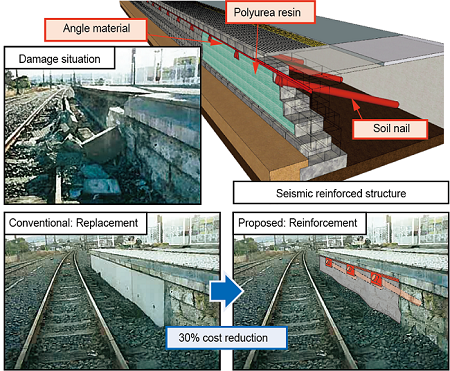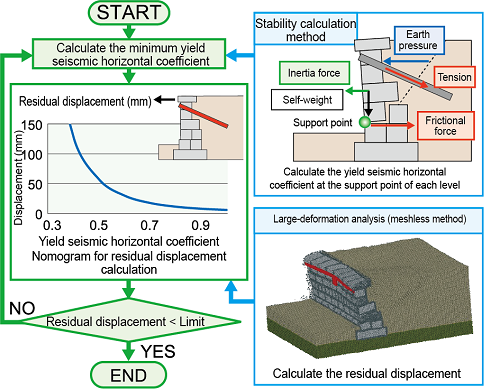1. Seismic reinforcement method for masonry embankment type train platforms
In past earthquakes, many of the masonry walls that make up masonry embankment type train platforms have tumbled or tilted, and seismic reinforcement methods to prevent such damage are required. Conventional seismic reinforcement requires the replacement of platforms, which is expensive. Therefore, we have developed a low-cost seismic reinforcement method that does not require replacement of platforms.
The developed reinforcement method combines spraying of polyurea resin to prevent slip-out of stacked stones, soil nails to prevent collapse, and angle materials to connect them (Fig. 1). Since this method does not require the replacement of platforms, it can be conducted for about 70% the cost of conventional methods. We also have proposed a design method for seismic reinforcement of the masonry embankment type train platform that combines the "yield seismic horizontal coefficient" obtained by calculating the stability at each level of the stacked stones during an earthquake and the "nomogram for residual displacement calculation" obtained by large deformation analysis using the meshless method to calculate the residual displacement of the masonry embankment type train platform (Fig. 2).
Using a full-scale model of a masonry embankment type train platform reinforced with the proposed design method, we verified the effect of seismic reinforcement under a large earthquake (maximum acceleration of 1000 gal), and found that the displacement at the top of the masonry wall was less than the limit value, confirming the effectiveness and validity of this design method for reinforcement (Fig. 3).
Other Contents
- 1. Seismic reinforcement method for masonry embankment type train platforms
- 2. Anti-bridge-collapse device with seismic control function that can be installed in narrow spaces
- 3. High-accuracy estimation method for earthquake motion at bedrock during large-scale earthquake
- 4. Method to control snow accretion around a bogie using traveling wind
- 5. Method for detecting obstacle on railway tracks using an on-board monocular camera
- 6. Method to detect passengers approaching vehicles using vehicle side cameras
- 7. Brake control method to compensate for reduced braking force
- 8. Vehicle-mounted measuring device for gauge and twist under loaded condition
- 1. Seismic reinforcement method for masonry embankment type train platforms
- 2. Anti-bridge-collapse device with seismic control function that can be installed in narrow spaces
- 3. High-accuracy estimation method for earthquake motion at bedrock during large-scale earthquake
- 4. Method to control snow accretion around a bogie using traveling wind
- 5. Method for detecting obstacle on railway tracks using an on-board monocular camera
- 6. Method to detect passengers approaching vehicles using vehicle side cameras
- 7. Brake control method to compensate for reduced braking force
- 8. Vehicle-mounted measuring device for gauge and twist under loaded condition



